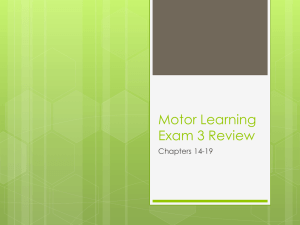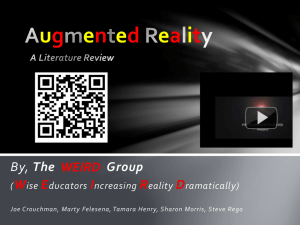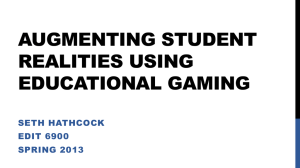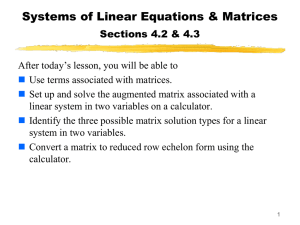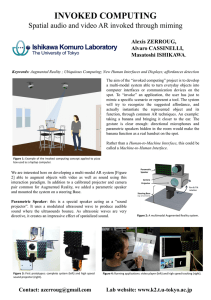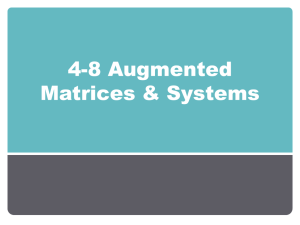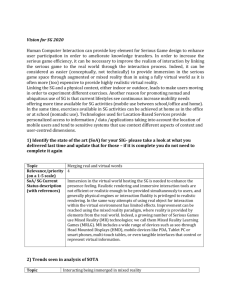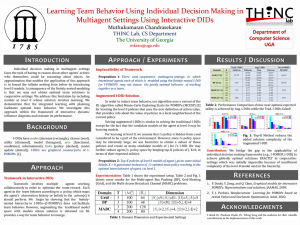3. results: how the first pedagogical material was constructed
advertisement
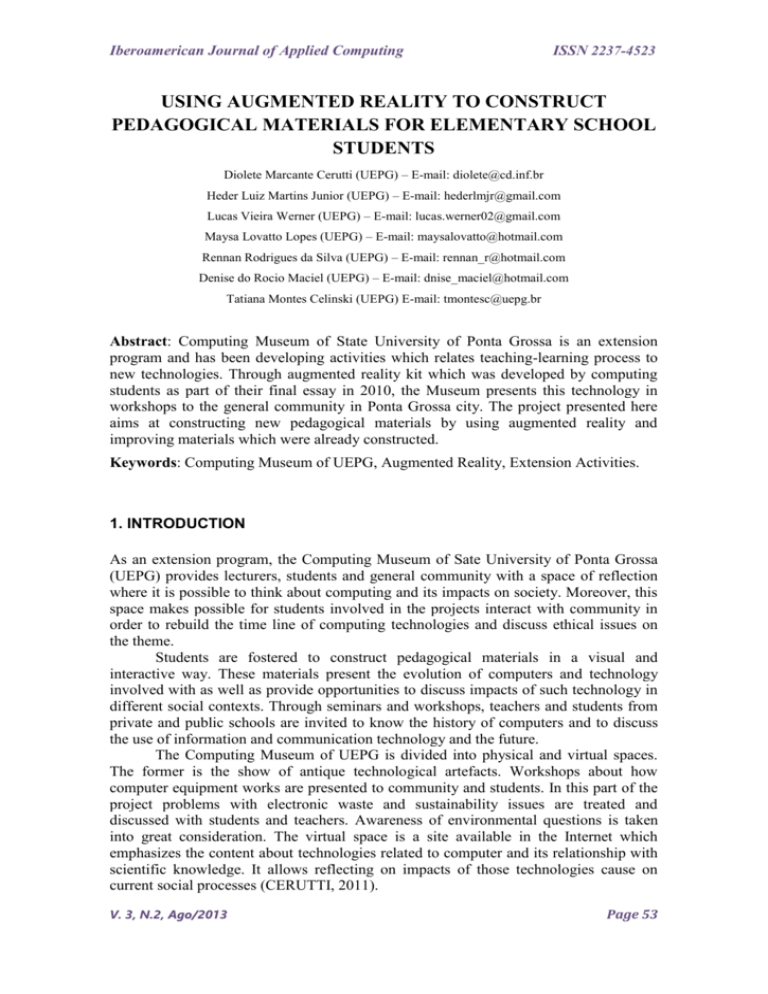
Iberoamerican Journal of Applied Computing ISSN 2237-4523 USING AUGMENTED REALITY TO CONSTRUCT PEDAGOGICAL MATERIALS FOR ELEMENTARY SCHOOL STUDENTS Diolete Marcante Cerutti (UEPG) – E-mail: diolete@cd.inf.br Heder Luiz Martins Junior (UEPG) – E-mail: hederlmjr@gmail.com Lucas Vieira Werner (UEPG) – E-mail: lucas.werner02@gmail.com Maysa Lovatto Lopes (UEPG) – E-mail: maysalovatto@hotmail.com Rennan Rodrigues da Silva (UEPG) – E-mail: rennan_r@hotmail.com Denise do Rocio Maciel (UEPG) – E-mail: dnise_maciel@hotmail.com Tatiana Montes Celinski (UEPG) E-mail: tmontesc@uepg.br Abstract: Computing Museum of State University of Ponta Grossa is an extension program and has been developing activities which relates teaching-learning process to new technologies. Through augmented reality kit which was developed by computing students as part of their final essay in 2010, the Museum presents this technology in workshops to the general community in Ponta Grossa city. The project presented here aims at constructing new pedagogical materials by using augmented reality and improving materials which were already constructed. Keywords: Computing Museum of UEPG, Augmented Reality, Extension Activities. 1. INTRODUCTION As an extension program, the Computing Museum of Sate University of Ponta Grossa (UEPG) provides lecturers, students and general community with a space of reflection where it is possible to think about computing and its impacts on society. Moreover, this space makes possible for students involved in the projects interact with community in order to rebuild the time line of computing technologies and discuss ethical issues on the theme. Students are fostered to construct pedagogical materials in a visual and interactive way. These materials present the evolution of computers and technology involved with as well as provide opportunities to discuss impacts of such technology in different social contexts. Through seminars and workshops, teachers and students from private and public schools are invited to know the history of computers and to discuss the use of information and communication technology and the future. The Computing Museum of UEPG is divided into physical and virtual spaces. The former is the show of antique technological artefacts. Workshops about how computer equipment works are presented to community and students. In this part of the project problems with electronic waste and sustainability issues are treated and discussed with students and teachers. Awareness of environmental questions is taken into great consideration. The virtual space is a site available in the Internet which emphasizes the content about technologies related to computer and its relationship with scientific knowledge. It allows reflecting on impacts of those technologies cause on current social processes (CERUTTI, 2011). V. 3, N.2, Ago/2013 Page 53 Iberoamerican Journal of Applied Computing ISSN 2237-4523 The Virtual Museum presents content about the informatics history to users. However, it is important to make the explorative activity more interactive in order to foster reading the content. In this way, the concept of interaction design was used where Preece et al. (2005) argues that the design of interactive products must provide support to quotidian activities in both work and home. One of the aims of the Museum is to engage students into development activities of interactive pedagogical materials for the Museum. So, this article presents a study developed by Bachelor in Informatics students as part of their final essay. The material was composed by using augmented reality as technology to produce that material for elementary school students. Initially, the material had students as focus. However, through questionnaires and talking with teachers, it was realised the need to concentrate efforts on the improvement of this material to teacher to use it with flexibility. The material would comprise every kind of content in order to provide teachers with flexibility to change the content as they wanted. In this sense, this article also presents the development of a new graphical interface to teachers (or less expert users) in order to they can change or adapt the content of the class to their own needs. 2. THEORETICAL BASIS: AUGMENTED REALITY Augmented reality (AR) is a term to define a different way of interacting with computers and it has become present in everyday life. This can join the real and virtual worlds in order to open up different ways of interaction and expand this interaction between these two worlds by looking at the reality in a digital way. By following a model based on overlapping of virtual objects with objects from the real life this technology can be used, for example, for entertainment, marketing, medical processes, in the industry and for improving the teaching and learning processes of content in the classroom. AR can be defined as mix of three basic components which are a combination of real and virtual reality, interactivity in a real time and to be registered in three dimensions (AZUMA, 1997, p. 356). There is also the possibility to use a real object as reference which can be interpreted to create a virtual one. Thus, a video camera can be used to capture images and the software that can mixture those images and interpret the code. One of the first software based on augmented reality was known as HeadMounted Display. In the year of 1968 it was able to make virtual information allocation over physical objects and it was created by Ivan Sutherland Hautsch (2009). After the emergence of the term Augmented Reality one project was developed for mobile equipment based on GPS (Global Positioning System). The main aim of this project was to help blind people (or with low degree of vision) and it used as methodology the overlapping of captured images with sound information. According to Houtsch (2009), knowledge about augmented reality has been spread since few time with the constant use of two dimensions codes (2D) which was developed to overcome the limitations of the bar code and optimize the tasks. Augmented reality has higher capacity of storage of information than bar code. In this case, it combines two dimensions code with software which can read them. Augmented reality is based on gathering field marks, tags, images or something else pattern which can have its movement captured as reference. Software based on augmented reality should be programmed to identify those references and thus to know V. 3, N.2, Ago/2013 Page 54 Iberoamerican Journal of Applied Computing ISSN 2237-4523 what to do from pre-defined actions. In general terms, Hauscht (2009) explains that it is possible to define steps to use software which is based on augmented reality as: - Capturing images with a camera; - Images are transmitted to the software in real time; - Software recognizes pre-programmed images in a data base; - Software identifies the actions to be taken through the image sent – the actions are pre-defined; - Output device builds up the virtual object on the actual image and displays this set. Development tools for AR In order to develop software based on augmented reality there is several tools in the market which can help developers such as ArtoolKit , ARToolKit Plus, ARTag, Dart, OSGART. In this work, two tools were studied but only one was selected to construct the software based on AR. The first was ArToolKit, it consists in library in C Language with which is possible to create interfaces of augmented reality. By using the method of direct vision by video it detects images of markers. The second was Ezflar, it is a library which was developed by developers of Newspaper O Estado de Sao Paulo. Ezflar allows developing application of AR without a need of programming. Its code in ActionScrip3 was created based on libraries as FLARManager, FLARToolkit and Papervision3D. Thus, the fact that ArToolKit is open code (CONSULARO, 2004) can be considered as a differential point for those developers with technical knowledge to optimize the tool. Therefore, such characteristic makes difficult for novice users to use this set of tools. ArToolKit was used in this study because developers were able to deal with technical issues and then to build the software which was used for demonstrations in workshops at schools. Limitations of AR based on computer vision ArToolKit calculates the viewpoint of the camera relative to a marker to perform the overlap of virtual objects on real world. However, this task has some limitations which directly influence the success of AR applications (Consularo, 2004). Objects can be only displayed whether the markers were completely read. In this case, it can impact on the size of the marker and consequently on the size of the virtual object and its movements. There is also limit on the slope of the marker in respect to optical axis of the camera. The larger the size of the marker the largest the distance in which it can be detected, but it is difficult to perform tracing it. Moreover, full of detail standards have reduced efficacy. Another aspect is the lighting, which can create reflections and bright regions in the marks of the paper making it difficult to detect by software. 3. RESULTS: HOW THE FIRST PEDAGOGICAL MATERIAL WAS CONSTRUCTED The ARToolKit was chosen because it is a set of free tools for non-commercial purposes as well as having open source enabling adapting applications of the tool. To minimize some limitations of augmented reality it was decided to construct the markers in the format of cubes (Figure 1), as they keep the plane figure which facilitates V. 3, N.2, Ago/2013 Page 55 Iberoamerican Journal of Applied Computing ISSN 2237-4523 reading by the camera, and prevent children put your fingers on the marker making it impossible to read. Figure 1 – Cubes used in the workshops Source: http://www.uepg.br/proex/anais/trabalhos/281.pdf Workshops with children This extension activity was developed by four students: two students of the course of Computing Engineering and two students of the course of Bachelor of Computing. The workshops began in March 2012 and used the first version of the material with augmented reality (using the ARToolkit and the cubes as shown in Figure 1). Four workshops with three public schools for students in fourth and fifth grade of elementary school, a workshop with students of the third year of high school and three shows at Extension events were held so far (May 2013). The workshops amounted participation of 86 elementary school students and Extension events approximately 150 participants (students, teachers and the community at large). Currently, workshops are held in public and private schools in the region of Ponta Grossa. During the activity, students are informed about the project and advised on application usage. To carry out the activity are needed 16 students divided equally into four teams. For each team member is given a cube with six markers to be positioned in front of the camera until the figure is showed for analysis. In this activity the student must determine whether the displayed figure is from the area of computer science and is old equipment or not. Moreover, competition is organized in the way that the team that set the figures more efficiently and effectively is the winner. Students are observed during interaction with the application. After that, students are asked to answer a questionnaire about the workshop and the application. One aspect to be considered is that the purpose of the activity will not only generate knowledge, it also stimulates critical thinking, competitiveness and team collaboration. Thus, in order to develop the new version of the augmented reality application, allowing teachers to optimize the application according to your preference, a study of the concepts involved and the tools that will be used was performed. The characteristics of the proposal are described in the following topics. 3.1. The Concept of Graphical User Interface The means by which the human part requests to the program the execution of tasks, some answer, or any communication between the parties is made by an interface V. 3, N.2, Ago/2013 Page 56 Iberoamerican Journal of Applied Computing ISSN 2237-4523 (PREECE ET AL, 2005). Often confused with the software itself, the interface is very important in the acceptance of software, since, of course, customers are attracted by the ease of handling, attractive screens with good design as well as the self-explanatory visual components. These characteristics show the need for a good interface for software. Graphical environment is software designed to facilitate and make practical use of the computer through visual representations of operant system. According Deitel (2003) the user interface allows interaction with digital devices through graphical elements such as icons, windows, menus, and pointers and other visual indicators. From this point of view the basic and fundamental problem in the area is the transformation of data into image. Therefore, the purpose of the prototype of an interface for ARToolkit technology is making a viable tool for teachers to assemble your own set of images without the aid of a programmer to start the application. In this aspect, the first screen of the application was constructed by considering simplicity, in order to facilitate usability. It was based solely on descriptive buttons in contrary to initial design in which the programmer must open the root folder of the file and explore for all folders to find the file which is responsible for video playback and the capture of the markers. Therefore, the Java development platform was chosen because its facilities to access the graphics library. 3.2. Creating Java Interface The classes used for creating graphical user interfaces as well as to provide them functionality are grouped into two major packages: java.awt (core package) and javax.swing (extension package). Swing Created in 1997, most components are written, manipulated and displayed completely in Java, without assistance, they are considered simple and provide uniform appearance and functionality in any platforms (DEITEL, 2003) (Figure 2). Figure 2 – Swing interface. AWT - Abstract Windowing Toolkit The GUI components of AWT (Figure 3) appeared in Java in version 1.0, features of the user platform. Thus, the appearance of the components differs when run on different operating systems, designed so that each virtual machine implements the interface software. This may be desirable because it allows the software to use the GUI components that are already familiar, but the layout can be changed by varying the platform (FRIENDLY, 2003). V. 3, N.2, Ago/2013 Page 57 Iberoamerican Journal of Applied Computing ISSN 2237-4523 Figure 3 – Comparison between AWT and Swing interfaces First layout The whole layout was produced in Java (Figure 4), specifically in the javax.swing library, due to its characteristic called appearance of metal. It means that the appearance does not change regardless of the operating system in order to prevent any changes and the user does not understand the operation of the program. . Figure 4 - First layout The first button will be responsible for video playback, that is, implementation of mixed reality. Its functionality is basically to open the "simpleVRML" application, and further bring the user to the camera settings that are already defined by the application and only need a simple confirmation. To compile this project in Java, the library glut.h and openGL.lib package (implemented by the library jogl.h) are required. The study was based on 2D pictures. In case of 3D pictures and animations the openVRML.lib, libpng.lib, lipjpeg.lib, zlib.lib, artln.lib libarvrmld.lib and libraries should be added. V. 3, N.2, Ago/2013 Page 58 Iberoamerican Journal of Applied Computing ISSN 2237-4523 4. CONCLUSIONS By analysing the workshops the Museum of Computing project developed it was noted great interest on the part of both students and teachers in relation to the pedagogical material which was based on augmented reality. The design and presents the technology of augmented reality, was able to arouse the interest of computer interaction with the educational environment. Among the schools in which the workshop was developed many requested to keep informed about new technologies. Despite the good results the applicability of the project is limited by the need for computer equipment such as digital cameras. Materials that in some schools, are not always available for students. The university students involved in the Museum of Computing project aims that the new interface is understandable to users in order to disseminate technology, to simplify the learning of complex content and encourage interaction with the means of computer based learning. REFERENCES AZUMA, R. T. et al. Recent Advances in Augmented Reality. IEEE Computer Graphics and Applications, v .21, n.6, p. 34-47. 2001. AZUMA, R. T. A Survey of Augmented Reality, UNC Chapel Hill, In Presence: Teleoperators and Virtual Environments, 1997. CERUTTI, D. M.L., CELINSKI, T.M., IELO, F. G. P. F., DUDA R., VILLALBA, R. D. A., MELO, G. A.Museu da Computação da UEPG. Ensino-Pesquisa-Extensão e o Museu Virtual In: CBEU – Congresso Brasileiro de Extensão Universitária, 2011, Porto Alegre. CONSULARO, L.A.; CALONEGO JR, N.; DAINESE, C.A.; GARBIN, T. R.; KIRNER, C.; TRINDADE, J.; FIOLHAIS, C. - ARToolKit:Aspectos Técnicos e Aplicações Educacionais. In: Cardoso, A.; Lamounier Jr, E. editores. Realidade Virtual: Uma Abordagem Prática. Livro dos Minicursos do SVR2004, SBC, São Paulo, 2004, p. 141-183. DEITEL, H. M., DEITEL P. J. Java Como Programar. Bookman, Quarta Edição, 2003. FRIENDLY, L., CAMPIONE, M., WALRATH, K., HUML, A.The Java Tutorial.Sun Microsystems, Terceira Edição, 2003. Available in http://java.sun.com/docs/books/tutorial/. Access 10 jun. 2013. HAUTSCH, O. Como funciona a realidade aumentada, 2009. Available in http://www.tecmundo.com.br/realidade-aumentada/2124-como-funciona-a-realidadeaumentada.htm. Access 10 jun. 2013. V. 3, N.2, Ago/2013 Page 59 Iberoamerican Journal of Applied Computing ISSN 2237-4523 PREECE, J. et al. Interaction Design. Porto Alegre: Bookman, 2005. V. 3, N.2, Ago/2013 Page 60
